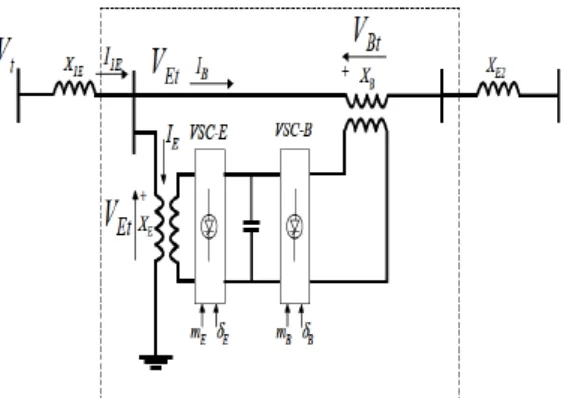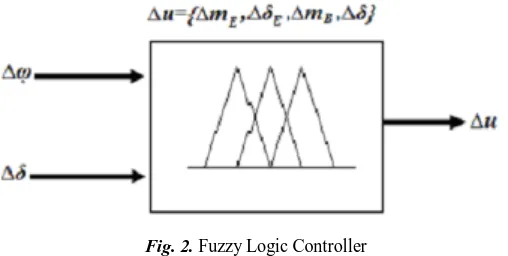ISSN: 2278-067X, Volume 1, Issue 6 (June 2012), PP.10-16
www.ijerd.com
Power System Damping Oscillations in Smib with Pss-Fuzzy
Upfc Controller
Kodukula Sowmya
1, P.Swathi
2, K.Vijay Kumar
3, Indranil Saaki
4,
1
PG Student, Department Of EEE, DIET,Ankapalli, Visakhapatnam, AP, INDIA.
2Assistance Professor, Department Of EEE, DIET,Ankapalli, Visakhapatnam, AP, INDIA. 3
Associate Professor, HOD, Department Of EEE, DIET,Ankapalli, Visakhapatnam, AP, INDIA.
4Assistance Professor, Department Of EEE, Sri Chaitanya Engineering College, Visakhapatnam, AP, INDIA.
Abstract––Low frequency electromechanical oscillations are inevitable characteristics of power systems and they greatly affect the transmission line transfer capability and power system stability. Traditionally, power system stabilizers (PSS) are being used to damp these oscillations. Unified Power Flow Controller (UPFC) is a well-known FACTS device that can control power flow in transmission lines. It can also replace PSS to damp low frequency oscillations effectively through direct control of voltage and power. In this paper a liberalized Philips-Heffron model of a (Single Machine– Infinite Bus) power system with a unified power flow controller is considered. The designed fuzzy-based UPFC controller adjusts four UPFC inputs by appropriately processing of the input error signal, and provides an efficient damping. The results of the simulation show that the UPFC with fuzzy-based controllers is effectively damping the LFO.
Keywords—Low frequency Oscillations (LFO), Unified Power Flow Controller (UPFC), Fuzzy logic, Damping controller, Flexiable AC transmission System (FACTS)
I.
INTRODUCTION
The growth in the demand for electric power is ever increasing. Simultaneous growing demand of power and environment concern necessitated a review of the traditional power system concepts and practices to achieve greater operating flexibility and better utilization of existing transmission system. Rapid development of power electronics technology provides exciting opportunities to develop new power system equipments for better utilization of the excitin g system.flexible AC transmission systems (FACTS) devices, which provides the needed correction of transmission functionality in order to fully utilize the existing transmission systems. FACTS technology based on use of reliable high speed power electronics, advanced control been demonstrated successfully and continues to be implemented at transmission locations in various parts of the world . The installed FACTS controllers have provided new possibilities and unprecedented flexibility aiming at maximizing the utilization of transmission assets efficiently and reliably.
Now adays, the electric power system is in transition to a fully competitive deregulated scenario. Under this circumstance, any power system controls such as frequency and voltage controls will be served an ancillary services. Especially, in the case that the proliferation of non-utility generations, i.e., Independent Power Producers (IPPs) that do not possess sufficient frequency control capabilities, tends to increase considerable. Furthermore, various kinds of apparatus with large capacity and fast power consumption such as magnetic levitation transportation, a testing plant for nuclear fusion, or even an ordinary scale factory like a steel manufacturer, etc., increase significantly. In fut ure when these loads are concentrated in a power system, they may cause a serious problem of frequency oscillations. The conventional frequency control, i.e., governor, may no longer able to absorb these oscillations and this becomes challenging and is highly expected in the future competitive environment.
The problem of poorly damped low frequency oscillations associated with generator rotor swings has been a matter of concern to Power System Stabilizer (PSS). In addition, HVDC, SVC controllers have also been used to damp these low frequency oscillations. The advent of high power electronic equipments to improve the utilization of transmission capacity provides system planners with additional leverage to improve stability of the system. Traditionally, power system stabilizers (PSS) are being used to damp these oscillations. Unified Power Flow Controller (UPFC) is a well-known FACTS device that can control power flow in transmission lines. It can also replace PSS to damp low frequency oscillations effectively through direct control of voltage and power.
This paper presents a new approach to the implementation of the UPFC based on a multiple input single output fuzzy logic controller in a single Machine infinite bus power system.
II.
DYNAMIC MODELING OF POWER SYSTEM WITH UPFC
Fig. 1. UPFC installed in a single-machine infinite-bus power system.
A linearized model of the power system is used in studying dynamic studies of power system. In order to consider the effect of UPFC in damping of LFO, the dynamic model of the UPFC is employed. The Dynamic model of the SMIB with UPFC can be represented as
Δδ 0 ωo 0 0 Δδ
Δώ -K1/M -D/M -K2/M 0 Δω
ΔE'q = -K4/T'do 0 -K3/T'do 1/T'do ΔE'q
ΔEfd -KAK5/TA 0
-KAK6/TA -1/TA ΔEqe
Δνdc K7 0 K8 0
0 0 0 0 0 ΔmE
- Kpd/M -Kqe/M -Kpδe/M -Kpb/M -Kpb/M ΔδE
III.
DESIGN OF FUZZY LOGIC CONTROLLER
There are two major types of fuzzy controllers, namely Mamdani type and Takagi- Sugeno (TS) type. The classification depends on the type of fuzzy rules used. If a fuzzy controller uses the TS type of fuzzy rules, it is called a TS fuzzy controller. Otherwise, the controller is named a Mamdani fuzzy controller. Throughout this paper, attention is focused on the Mamdani type fuzzy controller in order to damp the low frequency oscillations of the power system.
Angular velocity deviation Δω and load angle deviation Δδ is used as the fuzzy controllers inputs. One of the upfc inputs has been controlled via fuzzy controller output as shown in Fig. 2.
Fig. 2. Fuzzy Logic Controller
Seven membership functions are used in this work are triangular and trapezoidal in shape. The inputs and ouputs are fuzzified using seven fuzzy sets: LN (large negative), MN (medium negative), SN (small negative), Z (zero), SP (small positive), MP (medium positve), and LP(large positive).The membership functions of the input and output signals are shown in Fig. 3, Fig. 4 and Fig. 5.
The rules used in this controller are chosen as follows:
44. If δ is LN and is Δw MP then Δu is LP. 45. If δ is LN and is Δw SP then Δu is LP. 46. If δ is LN and is Δw VS then Δu is LP. 47. If δ is LN and is Δw SN then Δu is LP. 48. If δ is LN and is Δw MN then Δu is LP. 49. If δ is LN and is Δw LN then Δu is LP.
The membership functions of the inputs, output and rule base for all the controllers can be the same. The only difference is the range of these values.
The membership functions of the inputs, output and rule base for all the controllers can be the same. The only difference is the range of these values.
IV.
SIMULATION RESULTS
Firstly Simulation is done with the help of MATLAB software for the model of SMIB with UPFC as shown in the section 2. taking step change in mechanical input power (Pm = 0.01 pu.). In This simulation UPFC has no controller. The results obtained shows that the system is having oscillations and the system is poorly damped as shown in Fig. 6.
REFERENCES
[1]. Hingorani, N.G.: ‘High power electronics and flexible AC transmission system’, IEEE Power Eng. Reo., July 1988. [2]. Kundur, P.Klein, M., Roger, G.J. and Zywno, M.S.: ‘Application of power system stabilizers for enhancement of overall
system stability’, IEEE Trans. on Power System, 4, (2), 1989, pp. 614-626.
[3]. Ewart, D.N. et al.: ‘Flexible AC transmission systems (FACTS) scoping study’. EPRI Report EL-6943, 1990:
[4]. L. Gyugyi ‘Unified Power Flow Control Concept for Flexible ac Transmission Systems.’ IEE Proceedings-C, Vol. 139, No.
4, July 1992, p. 323.
[5]. L. Gyugyi and C.D. Schauder, et al. ‘The Unified Power Flow Controller : A New Approach to Power Transmission
Control.’ IEEE Transactions on Power delivery, Vol. 10, No. 2, April 1995, p. 1085.
[6]. K.S. Smith, L. Ran and J. Penman. ‘Dynamic Modelling of a Unified Power Flow Controller.’ IEE Proceedings-C, Vol. 144,
No. 1, January 1997, p. 7.
[7]. Papic and P. Zunko et al. ‘Basic Control of Unified Power Flow Controller.’ IEEE Transaction on Power Systems, Vol. 12,
No. 4, November 1997, p. 1734.
[8]. A. Edris and K. Gyugyi, et al. ‘Proposed Terms and Definitions for Flexible ac Transmission Systems (FACTS).’ IEEE
Transactions on Power Delivery, Vol. 12, October 1997, p. 1848.
[9]. H.F. Wang ‘Damping Function of Unified Power Flow Controller.’ IEE Proceedings-C, Vol. 146, No. 1, January 1999, p. 81.
[10]. H. F. Wang. ‘A Unified Model for the Analysis of FACTS Devices in Damping Power System Oscillations — Part III :

